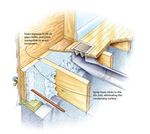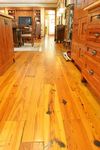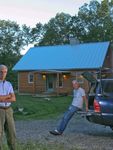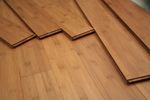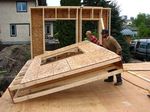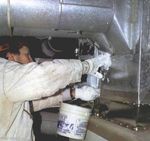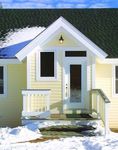Getting Started in Green Building-A Primer for Beginners
←
→
Page content transcription
If your browser does not render page correctly, please read the page content below
Getting Started in Green Building—A Primer for Beginners Unclear on what it means to build green? Green building means building houses that are energy efficient, durable, and won't make people sick after they move in. It also means using less materials and making better use of the ones you buy. We can do this by designing and building houses... • Efficiently • To last a long time • To use less water and energy • That are healthy to live in In short, we can build green by building even better houses than we've been building— we take the next step in quality.
How do we do that?
Begin by reading the 20 Questions.
1. What is Green Building?
2. Why Is Green Building Suddenly Such a Big Deal?
3. Do Green Houses Cost More to Build Than Regular Houses?
4. What’s Wrong With The Way Regular Houses Are Built?
5. Are green houses designed any differently?
6. Do Green Houses Have to Look Weird?
7. Do I Need A Specialist to Build A Green House?
8. What if I already own a house? Can I make that green, too?
9. Can Houses be “Too Insulated ” or “Too Tight"?
10. What Is Green Certification, And How Does It Work?
11. Are features like solar panels absolutely necessary?
12. Are there such things as green furnishings and carpeting?
13. Do Low-Flow Toilets Really Work?
14. What Is “Xeriscape” And Why is it Important?
15. If I use only green or recycled building products, is my house green?
16. How do I know when a building product is really green?
17. Can A Big House Be Green?
18. Are There Some Products That Do Not Belong in Any Green House?
19. Do I Have to be A Building Scientist To Build Green?
20. Is It Really Cheaper to Live In A Green House?
1. What is Green Building?
Green building is the next step in quality.
Green building is an approach to construction that can be applied to public and
commercial buildings as well as the houses we live in. It guides every step of design
and construction, from choosing a building site to installing a heating system. Green
building is alternately described as “sustainable” building, and ultimately this may be a
more accurate way of looking at it.Green buildings are as varied as the people who live in them. There is no single template for a green house. But even though green houses may look different from the outside, their designs are based on three broad principles: Energy efficiency. The house uses as little energy as possible. Whenever feasible, renewable forms of energy should replace fossil fuels, which by definition are not renewable. Conservation of natural resources. This broad objective recognizes that resources are finite. There is only so much timber, ore and water to go around, and what resources are available to us should be used thoughtfully. Seen through this lens, durability, low environmental impact and low maintenance all become important attributes for a house. High indoor air quality. Green houses are designed to be healthy houses. Moisture, mold, and radon don't plauge a green home. Building materials, furnishings, paints and finishes should not contribute toxins and irritants to indoor air. Even with clean air though, houses need mechanical ventilation that assures a steady flow of fresh air. When we see an Energy Star label on a new refrigerator or washing machine, we recognize it as a good thing. Green isn’t that simple. But understanding the principles behind sustainable building helps us make appropriate decisions about the houses we build.
2. Why Is Green Building Suddenly Such a Big Deal? There are a lot of reasons why green building is suddenly a big deal Sustainable building isn’t exactly a new phenomenon, but it has certainly taken root in a way that earlier efforts to change residential construction did not. Chalk it up to the coalescence of many things. Energy costs are one key. The frenzy in passive solar design that began with the energy crunch of the 1970s fizzled when fuel prices declined. We lost a powerful incentive to build more-efficient houses that were cheaper to heat and cool. Building energy efficient houses was pushed to a side rail and forgotten. But now that energy prices have gone back up, we have a much better understanding of how tenuous our foreign supplies of fossil fuels have become. Global climate change is another factor. Melting glaciers, disappearing Arctic ice, droughts and fierce storms—we’ve all read about them, and many of us have experienced them firsthand. Researchers attribute at least some of these phenomena to a gradual increase in greenhouse gases, which is causing the planet to warm up. Houses are part of the climate-change equation because they consume a great deal of energy. So when scientists talk about our “carbon footprint,” we now have a direct correlation between what we do and the world around us. We know more about how houses work than we used to. Building scientists who study the mechanics of why houses behave the way they do have helped promote designs that are more durable, more comfortable and healthier than conventional houses. This increased technical prowess has made it possible to apply sensible building practices to all kinds of architectural styles. Finally, the time was right for a shift in thinking. Just as Sarah Susanka struck a nerve with her “Not So Big” approach to residential design, proponents of sustainable building have made their case at just the right time. Homebuyers are apparently ready for a change, and the building industry is ready to follow. The fact that green-built houses last longer, have fewer problems, are cheaper to live in and keep their owners more comfortable—well, that doesn’t hurt.
3. Do Green Houses Cost More to Build Than Regular Houses? Green is often less expensive when all things are considered. Sustainable building often seems more expensive than conventional building. Many of the building materials that make houses more durable and easier to heat and cool aren’t cheap. Complicated systems that allow a certain amount of energy independence--photovoltaic and solar hot water panels, for instance—can be very pricey. Common sense would tell most builders that it costs more to spray 8 inches of polyurethane foam in the roof than it would to install fiberglass batts. But appearances can be deceiving. Take, for example, a decision to upgrade from double-pane to triple-pane windows. The windows will add thousands of dollars to construction costs. But they could eliminate the need for a warm-air register in front of each window, and the savings in labor and duct installation could offset the additional cost of the windows. In addition, the lower heating load means the size of the furnace can be downgraded. End result? Lower overall construction costs. Savings can come in other ways. Spending more money for more durable materials is cheaper in the long run because they won’t have to be replaced as often. Considering
life-cycle costs, rather than focusing solely on initial costs, can yield some surprising results. Green building isn’t an all-or-nothing proposition. As long as the basics are there, the house can be upgraded over time. If solar panels are an intriguing long-term option but not in the cards right now, for instance, pre-plumb for the panels and install them when the budget allows. 4. What’s Wrong With The Way Regular Houses Are Built? One word: Waste. It would be ridiculous to suggest that every house constructed in advance of the green- building boom is substandard, although some of them clearly are. There are many New England farmhouses entering their third century of service that are still sound, even if they are a little drafty. There also are houses 10 or 20 years old that have serious structural problems caused by sloppy workmanship, inappropriate or substandard materials or both. What’s really wrong with conventional building techniques is that they are often haphazard and wasteful. Houses built with too little forethought can be uncomfortable, expensive to heat and cool and ill suited to the site. Worse, they can be unhealthy
places to live because of airborne mold, toxic chemical off-gassing and overall poor air quality. Green building is an approach that helps designers, builders and all of the other trades that get involved. There are specific, measurable steps that builders can employ to make sure the house will reach its full potential for durability, comfort and efficiency. Builders can be reluctant to try new things. That’s understandable, because they’re the ones left holding the bag when something doesn’t go right. But the practices and principles behind green building are now well enough understood that risks are minimal. The payoff can be very rewarding for both the builder and the homeowner. 5. Are green houses designed any differently? Yes, or at least they should be Here’s how it works with conventional construction: a designer or architect draws up plans, which are turned into construction drawings. A general contractor hires a series of subcontractors, each with a specialty. Some of the trades may not be very familiar with the project until they get to the site. Subcontractors may not have spent any time talking with each other and consequently don’t understand how their work affects the work of others.
All sorts of trouble can follow. If the house is framed without regard to the needs of the HVAC system or insulation, for example, the house simply can’t perform as well as it otherwise would. Green builders recognize that a house is a number of interrelated parts and systems that all have to work together. At its best, designing a green house involves every member of the construction “team” from the start. Everyone has a chance to listen, to contribute and to look for better ways to achieve a common goal. This process is called “integrated design” and it may include group meetings, called “charrettes,” for various phases of design and construction . Builders who have tried this approach sometimes find unexpected efficiencies and savings. As important, those lessons can be applied to houses in the future. 6. Do Green Houses Have to Look Weird? In a word, no. But they can if you want them to. The boom in passive solar design during the 1970s encouraged lots of owner-builders to construct energy-efficient houses. Some excellent books on energy conservation and building theory were published at the time—books such as The Owner Built Home, by Ken Kern (1972), and From the Ground Up, by John Cole and Charles Wing (1976). People realized there were alternatives to conventional building techniques that promised greater self-sufficiency and lower costs—not unlike our situation these days.
But some of those houses did look weird, or at least they didn’t look traditional. A generation later, people may remember those early efforts with alarm and wonder if the current green-building boom will mean another crop of ugly houses. In reality, sustainably built houses cover a huge architectural swath. The principles behind green building can be applied to virtually any style of house, from modernist to traditional. It’s not what it looks like that matters, but how it works. Even photovoltaic panels can be incorporated directly into the structure so they become virtually invisible. These “building integrated” panels are one of the best examples of how even ultra-green features don’t have to detract from design. Many green features are far less obvious than that, apparent only if you could take the house apart and peer into wall cavities or behind the siding. One of the strongest cases for sustainable building is its adaptability. 7. Do I Need A Specialist to Build A Green House? Anyone can build green, but better builders find the transition easier In theory, any contractor could build a green house because the step-by-step process isn’t dramatically different from the ones used for building any other kind of house. It’s not like asking a lawyer to dig clams.
But in practice, there is a learning curve. Builders need an appreciation for at least the basics of building science—the role of air and moisture barriers, for example, or why there should be an effective drainage plane behind the siding. Builders well schooled in traditional techniques may not have spent any time thinking about those things, or understand green house theories incompletely. Construction is not an industry that changes quickly. Many builders do things a certain way because that’s what they were taught and that’s what they know. It takes time and effort to learn new approaches, and some builders may not think they can afford either. As time passes, though, builders will have to learn more sustainable design or they’ll be out of business. Consumers know more than they did about the subject even a few years ago, and they will increase pressure on the construction industry to produce houses that are more durable and energy efficient. In the meantime, it would be smart to hire someone with experience. At the least, look for an architect or designer who knows about sustainable building and is willing to coach a builder along.
8. What if I already own a house? Can I make that green, too? To a point, yes. Some parts of the structure are going to be tough to change. The foundation, framing, wiring and plumbing all are components integral to the house. Although an unlimited renovation budget opens all kinds of doors, altering these parts of the house can be very expensive and beyond the means of many homeowners. That said, there are many upgrades and changes that will make a house more energy efficient, healthier and more durable. Upgrading windows and heating and cooling equipment, putting more insulation into the attic, sealing air leaks, installing ventilation equipment, and switching to low-VOC paints and finishes all are examples of positive steps. (VOC is shorthand for volatile organic compounds, which include environmentally harmful solvents that evaporate into the atmosphere after paints or other finishes are applied.) Keeping sustainable building practices in mind during routine maintenance and repairs can help. Let’s say you need new siding. Wrapping the house with an inch or two of rigid foam insulation before the new siding goes on can mean substantial energy savings. If you need new windows, why not choose high performance versions designed for your climate? Once again, it boils down to applying the principles of green building to the decisions we make. Books and magazines that routinely deal with this topic are a good start.
9. Can Houses be “Too Insulated ” or “Too Tight"? No. Green homes are insulated well, tightly built, and well ventilated Let’s take these issues one at a time. The “too tight” theory holds that houses need to breathe. Traditionalists can point to old houses and claim the only reason they’re still standing is because air leaks amount to natural ventilation that dries everything out and keeps the house healthy. In reality, air leaks mean you’ve lost control of air movement. Air and moisture can be forced into wall and ceiling cavities where water vapor condenses and fosters the growth of mold. Warm air exiting the top of the house can draw in cold air to replace it, wasting heat and energy. In many ways, uncontrolled air movement wastes energy and increases the risk of long-term damage to building components. Effective air and moisture barriers reduce those problems, but they come with a few caveats: Tight houses need mechanical ventilation to ensure a supply of fresh air to keep people healthy; and existing houses should not be tightened without assessing whether the existing combustion appliances have an adequate source of combustion makeup air.
As far as insulation goes, there may be a theoretical point of “too much,” but in most cases buildings have too little. At the very minimum, insulation should meet recommendations of the Department of Energy, but adding more is always a good thing. Properly insulated buildings are cheaper to heat and cool. Where insulation is added can be as important to how much is added. Walls and roofs with an extra layer of rigid insulation outside the framing help cut energy losses due to thermal bridging. What’s more, some types of insulation are inherently more effective than others. But using too much should be the least of our worries. 10. What Is Green Certification, And How Does It Work? A certified home meets certain construction standards that should translate into increased energy conservation, healthy indoor air and lower operating costs. There is not, however, a single government or private agency that doles out certifications—and that’s where it can get confusing. One of the oldest rating systems is the U.S. Department of Energy’s Energy Star program, which recognizes houses (as well as other products) that save energy. An Energy Star house must be at least 15 percent more energy efficient than homes built to the 2004 International Residential Code and 20 percent to 30 percent more efficient than standard construction. Some states have their own energy codes for residential construction.
But “green” goes beyond energy efficiency, so buyers who want a certified green house should be looking for a program with a more holistic approach. The best known is probably LEED for Homes. LEED, which stands for Leadership in Energy and Environmental Design, is the brainchild of the U.S. Green Building Council. It’s a highly structured rating system in which points are awarded to houses in a number of areas (site selection, the use of recycled materials, and energy and resource conservation, to name a few). LEED relies on independent inspectors, so builders can’t give their own houses a certification. LEED accreditation is also time consuming and expensive, so not all builders think it’s worth their time. It doesn’t necessarily mean their houses aren’t just as good. The National Association of Home Builders has its own set of green-building guidelines (NAHB Model Green Home Building Guidelines) that are as broad in scope as those of the LEED program. One big difference is that the builder, rather than third-party inspectors, is responsible for signing off on many of the construction requirements. The newest big national initiative is the ANSINational Green Building Standard (NGBS). The National Green Building Standard, also known as ICC-700, grew out of NAHB’s
earlier Model Green Building Guidelines and was approved in early 2009 by the American National Standards Institute. These are not the only green-building guidelines that builders and homeowners can turn to, and each program is going to be slightly different. Program guidelines are easily accessible on the Internet. Even if the language can get technical, anyone who spends some time studying program requirements should pick up a general idea of what that particular green designation means. 11. Are features like solar panels absolutely necessary? No — A single feature can not make a house green. Solar panels—which can provide electricity or hot water—are essential components of renewable energy systems and epitomize the goals of sustainable building. But they are not prerequisites for green building. Remember that green building covers dozens of areas, touching on everything from site selection and heating systems to interior finishes and solar orientation. Houses can be textbook green in some respects while falling somewhat short in others, and focusing on just a few obvious elements misses the point. Suppose, for example, a house has both solar hot water collectors and photovoltaic panels but also is stuck with leaky windows, inadequate insulation and a mold problem. Is this house green?
On the other hand, a house that is oriented to take advantage of the sun and has a tight building envelope and healthy interior free of mold and chemical contaminants is green in so many respects that a lack of solar panels is hardly a big deal. 12. Are there such things as green furnishings and carpeting? Yes. Look for locally-produced, VOC-free furnishings and finishes Both carpeting and furniture can degrade indoor air quality if they are manufactured or finished with materials that emit noxious chemicals, a process called off-gassing. Common sources of indoor air pollution are particleboard, medium-density fiberboard and other panel products manufactured with a resin called urea formaldehyde. The resin is inexpensive but it off-gasses formaldehyde, classified as a known human carcinogen by the International Agency for Research on Cancer. As the hazards of this common chemical have become more widely publicized, manufacturers have introduced panel products that use other adhesives and resins. Savvy cabinet companies market products that emit low levels of formaldehyde, and they are worth looking for. Paints and finishes that contain high levels of VOCs—volatile organic compounds—also lower indoor air quality, especially for people who have chemical sensitivities. State and federal authorities are clamping down on VOCs, and a number of products with very low VOC content are readily available. But you have to be careful. For instance, some paint colorants are high in VOCs even if the paint’s tint base is not. Read the fine print.
If you’ve got your heart set on carpeting, consider Green Label and Green Label Plus products or rugs that are made completely with natural fibers. The labeling program was launched by the Carpet and Rug Institute to identify carpeting, adhesives and cushions that emit low levels of VOCs. Carpeting probably isn’t the best choice for floor coverings in general because it can trap contaminants that would not accumulate on a bare floor—dust mites, chemical contaminants, pet dander. Choosing low-emission products is an obvious minimum standard. 13. Do Low-Flow Toilets Really Work? Of course they do The federal government decided that after 1994 toilets shouldn’t use any more than 1.6 gallons of water per flush. Manufacturers had to comply, but by most accounts their early efforts were a flop. That was a decade and a half ago. The redesigned low-flow models that followed work as well or better than older models that used as much as 7 gallons of water per flush. There is, in fact, a joint U.S.-Canadian evaluation program called Maximum Performance (or MaP) that uses soybean paste encased in latex to see just how well
these low-flow toilets work. And most of them work very well. Test results are easily accessible on the Internet. High-efficiency toilets use even less water than standard low-flow models, some as little as 1.1 gallons. Dual-flush toilets, which have separate flush modes for solid and liquid waste, are another water-saving option. The differences in performance may seem trivial, but switching from a standard to a low-flow toilet can save thousands of gallons of water per year. Replacing an old toilet with a low-flow model is a simple and fairly inexpensive way of conserving resources—a cornerstone of green building. 14. What Is “Xeriscape” And Why is it Important? Landscapes that thrive without water In a nutshell, xeriscape is an approach to landscaping and gardening that conserves water and otherwise uses site resources appropriately. The phrase, coined by Denver’s municipal water department, combines the Greek word for “dry” with landscape. Among other things, xeriscape encourages careful planning, efficient irrigation, soil improvements, the use of mulches and choosing appropriate plants for the site. Native plants need less watering and less chemical intervention to remain healthy.
Xeriscape is really about going to a site and finding exactly what you’d expect to find had humans not intervened. Suppose you bought a house lot in the desert. The last thing you’d find on the site was a lush, green lawn. But that’s exactly what our culture has encouraged, at the collective cost of millions of gallons of water and millions of pounds of chemical fertilizers and insecticides. The issue is especially sensitive in parts of the western U.S. where water is in short supply. It’s hard to justify the flagrant waste of water when there is so little of it to go around. In Las Vegas, Nevada, these concerns have prompted city officials to pay residents to tear up turf and replace it with plants that don’t need as much water. Since the program began, six square miles of lawn have been removed. Each square foot of removed turf saves about 55 gallons of water per year. Choosing appropriate plants is one of many ways that site development and landscaping can become more sustainable. Choosing permeable driveway and sidewalk materials, establishing rain gardens to control runoff and preserving deciduous shade trees to keep the house cooler in summer all are logical companions to xeriscape design.
15. If I use only green or recycled building products, is my house green? Tags: Decks, Materials storage, Residential Laundry Appliances No, but they don't hurt. Building products made from recycled products don’t make a house green by themselves any more than solar or photovoltaic panels do. But keeping the goals of sustainable building in mind can guide purchasing decisions in the right direction. Take something innocuous, like a stone countertop or a bamboo floor for a kitchen . Stone and bamboo are natural materials that off-gas no hazardous chemicals and are extremely durable—all positives. But what if they are imported from the Far East or mined in a country where labor or environmental laws are suspect? Is the material still green? Well, not as much. It would be better to purchase flooring and stone locally, even if that limits the number of options. The same template can be applied to purchases of wood products. Illegal logging is rampant in some parts of the world, threatening regional ecologies and in some cases underwriting violent criminals. Buying lumber that has been harvested locally or certified as sustainable by a third-party, such as the Forest Stewardship Council, is a contribution toward green building.
But choosing appropriate materials is a lost effort if the house itself wastes fuel or is poorly designed and haphazardly built. Green products are becoming more plentiful all the time, and given the right context they are an important part of sustainability. It’s the context part we shouldn’t forget about. 16. How do I know when a building product is really green? 'Green' makes an eye-catching label for all sorts of products. It’s a bandwagon every marketing company in the U.S. would like to climb on. Confronted with this advertising claim, what we should be asking is, “OK, what makes it green?” Here are a few issues to consider: Is it manufactured or harvested locally? Less energy is needed to get local products to the end user. Buying locally also helps local economies. Is it healthy? Find out whether the product off-gasses volatile organic compounds, formaldehyde or other chemical irritants.
Is it durable? Spending more money for a product that lasts much longer than the norm represents a net savings. Is it made from recycled materials, and can it be recycled? An increasing number of products contain at least some recycled material, which means fewer virgin raw materials were needed to manufacture them. Products that can be recycled at the end of their service life means less strain on landfills. Will it save energy? Anything we can do to lower energy demands is positive. This is painfully obvious when it comes to fossil fuels, but don’t forget that a lot of electrical energy is derived from natural gas or coal. Making the right decisions about green products isn’t always as easy as it looks. In addition to the questions listed above, you might consider a variety of other issues, such as how much “embodied energy” the product contains. That’s a measure of the amount of energy it took to manufacture and ship a product. The problem is there aren’t any absolute standards for measuring these things. Buyers simply have to weigh a variety of concerns and do they best they can. Buying guides can be very helpful. One of them is Green Building Products: The GreenSpec Guide to Residential Building Materials. It lists everything from heat pumps to roof shingles. 17. Can A Big House Be Green? A contentious issue with a definitive answer: “It depends.” There’s no doubt that houses have been getting bigger. The U.S. Census Bureau reports that 26 percent of all new single-family houses built in 2007 were 3,000 square feet or larger. In some prosperous markets a 10,000-squaref-foot house doesn’t raise any eyebrows.
Even with all the sustainable features known to man, a 10,000-square-foot house built for a family of four can’t really be considered green. The reason is simple: It consumes a disproportionate share of materials and resources. The same house for an extended family of 20 would seem a lot greener. At the heart of the green building movement is the idea that resources are finite, no matter how much money you have. Lowering consumption is an important benchmark in sustainable building, and that thinking extends to the materials that go into a house as well as the energy that’s required to heat and cool it. An extravagantly large house that’s energy efficient and healthy is certainly better than one that wastes energy and is loaded with contaminants. But that doesn’t entirely justify the excesses of building a house big enough for 10 when only two people will live there. The LEED for Homesrating system addresses this issue directly. Big houses are penalized; small ones are rewarded. It’s “neutral” size recommendations range from 900 square feet for a one-bedroom house to 2,850 square feet for a five-bedroom house. These numbers won’t work for every family, but they’re a reasonable place to start.
18. Are There Some Products That Do Not Belong in Any Green House? Absolutely. Green houses are tighter than regular houses, so indoor air quality can be compromised by products and materials that off gas. Here are a few suggestions: Paints and stains with high levels of VOCs (volatile organic compounds). Generally speaking, oil-based finishes have higher VOC levels than do water-based products. Carpeting that that does not carry the Carpet and Rug Institute’s Green Label or Green Label Plus. Exotic hardwoods (mahogany, teak and the like) that is not certified by the Forest Stewardship Council or a like organization.
Old-growth softwoods (Douglas fir, redwood and yellow cedar, for example) that have not been sustainably harvested. Pressed wood products, such as particleboard, made with urea formaldehyde adhesives. Windows and doors that do not meet Energy Star guidelines. Vinyl flooring. Heating and cooling equipment with low energy-efficiency ratings. At almost every turn, builders and homeowners have choices about the products and materials they buy. Look for durable, nonpolluting products and avoid those that have health, environmental and energy drawbacks. 19. Do I Have to be A Building Scientist To Build Green? Knowing something about building science helps, yes. Builders who are just starting to dive into green building will need a grasp of basic techniques: how to make sure the building envelope is tight, the pitfalls of sloppy HVAC installations, how much insulation to install and which types work best, how to install windows and doors so they don’t leak, what kind of roofing is appropriate for the climate.
Underlying all of these nuts-and-bolts issues are the principles of building science. For example, if a builder understands how and why moisture can be driven into wall and ceiling cavities, he or she will be more effective at preventing it. A builder may follow local practice by installing a polyethylene vapor barrier on the warm side of an exterior wall. But if the plastic is installed improperly, or is ripped and torn here and there, it’s really not going to be very effective. In this case, understanding the theory improves performance. Building science is helping a lot of people build better houses. Research at the Oak Ridge National Laboratory, the National Renewable Energy Laboratory, the Lawrence Berkeley National Laboratory and many other public and private facilities is making it easier to construct durable, safe and energy efficient houses. An enormous amount of information is available over the Internet, as well as in books and magazines. What about the homeowner? Those who have taken the time to educate themselves about the basics of building science will have more fruitful conversations with their builders, and in the end will probably make better decisions about where to put their money. Builders should not be expected to be scientists, too. But life will be a lot easier with an appreciation for the “whys” of building along with the “how.”
20. Is It Really Cheaper to Live In A Green House? Yes, and in more ways that one. Energy conservation is one of the main goals of sustainable building, and following the basics of green design certainly lowers the cost of heating and cooling. All of it makes a difference, so site the house to take advantage of the sun, create a tight building envelope, invest in adequate insulation and choose energy efficient heating and cooling equipment. The energy advantages of green design are becoming more obvious as the cost of fossil fuels increases. When energy was cheap, a little extra heating oil or natural gas wasn’t a big deal. But energy isn’t cheap anymore and fossil fuels are only going to get more expensive. Cutting consumption by building more-efficient houses is money in the bank. Taken to its limits, energy conservation strategies result in a “zero-energy” house, which produces as much energy over the course of a year as it uses. This isn’t easy to accomplish and requires the installation of photovoltaic panels to generate power. But
near-zero-energy houses can get most of the way there without as much reliance on these expensive devices. At the moment, zero-energy buildings are rare but they are likely to become much more common. Green houses also are designed to save money with lower maintenance costs. Choosing durable building products means they will have to be repaired or replaced less frequently. Durable building products don’t necessarily cost more. They just work better.
You can also read
